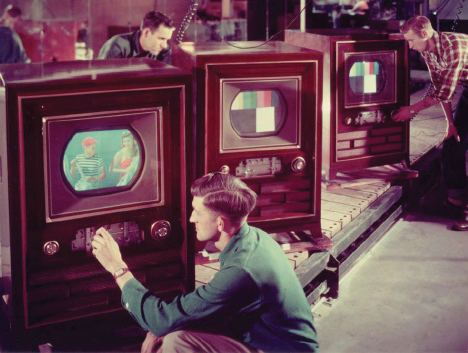Becoming a Mass Medium
Printed Page 228

Inspired by the ability to transmit audio signals from one place to another, inventors had long sought to send "tele-visual" images. For example, in the 1880s, German inventor Paul Nipkow developed the scanning disk, a large flat metal disk perforated with small holes organized in a spiral pattern. As the disk rotated, it separated pictures into pinpoints of light that could be transmitted as a series of electronic lines. Subsequent inventors improved on this early electronic technology. Their achievements pushed television from the development stage to the entrepreneurial stage and then to the mass medium stage—complete with technical standards, regulation, and further innovation (such as the move from black-and-white to color TV).
Television’s development and commercialization were fueled by a battle over patents between two independent inventors—Vladimir Zworykin and Philo Farnsworth—each seeking a way to send pictures through the air over long distances. In 1923, after immigrating to America and taking a job at RCA, the Russian-born Zworykin invented the iconoscope, the first TV camera tube to convert light rays into electrical signals. He received a patent for his device in 1928.
Around the same time, Farnsworth, an Idaho teenager, transmitted the first electronic TV picture by rotating a straight line scratched on a square of painted glass by 90 degrees. RCA accused Farnsworth of patent violation. But in 1930, after his high school teacher provided evidence of his original drawings from 1922, Farnsworth received a patent for the first electronic television and later licensed his patents to RCA and AT&T, which used them to commercialize the technology. He also conducted the first public demonstration of television at the Franklin Institute in Philadelphia in 1934—five years before RCA’s much more famous public demonstration at the 1939 World’s Fair.
The Development Stage: Establishing Patents
Television’s development and commercialization were fueled by a battle over patents between two independent inventors—Vladimir Zworykin and Philo Farnsworth—each seeking a way to send pictures through the air over long distances. In 1923, after immigrating to America and taking a job at RCA, the Russian-born Zworykin invented the iconoscope, the first TV camera tube to convert light rays into electrical signals. He received a patent for his device in 1928.
Around the same time, Farnsworth, an Idaho teenager, transmitted the first electronic TV picture by rotating a straight line scratched on a square of painted glass by 90 degrees. RCA accused Farnsworth of patent violation. But in 1930, after his high school teacher provided evidence of his original drawings from 1922, Farnsworth received a patent for the first electronic television and later licensed his patents to RCA and AT&T, which used them to commercialize the technology. He also conducted the first public demonstration of television at the Franklin Institute in Philadelphia in 1934—five years before RCA’s much more famous public demonstration at the 1939 World’s Fair.
The Entrepreneurial Stage: Setting Technical Standards
Turning TV into a business required creating a coherent set of technical standards for product manufacturers. In the late 1930s, the National Television Systems Committee (NTSC), a group representing engineers, inventors, network executives, and major electronics firms, began outlining industry-wide manufacturing practices and defining technical standards. In 1941 the Federal Communications Commission (FCC) adopted an analog standard (a 525-line image) for all U.S. TV sets (which at that time could show only black-and-white images). About thirty countries adopted this system, though most of Europe and Asia eventually adopted a system with slightly better image quality and resolution.
The Mass Medium Stage: Assigning Frequencies and Introducing Color
TV signals are part of the same electromagnetic spectrum that carries light waves and radio signals. In the early days of television, and before the advent of cable, the number of TV stations a city or region could support was limited because airwave frequencies interfered with one another (so you could have a Channel 5 but not a Channel 6 in the same market). In the 1940s, the FCC began assigning certain channels in specific geographic areas to prevent interference. In 1952, after years of licensing freezes due to World War II, the FCC created a national map and tried to distribute all available channels evenly throughout the country. By the mid-1950s, the nation had more than four hundred television stations in operation. TV had become a mass medium.
Television’s new status led to additional standards. In 1952, the FCC tentatively approved an experimental color system developed by CBS. But its signal could not be received by black-and-white sets. In 1954, RCA’s color system, which sent TV images in color but allowed older sets to receive the images as black-and-white, became the color standard.
